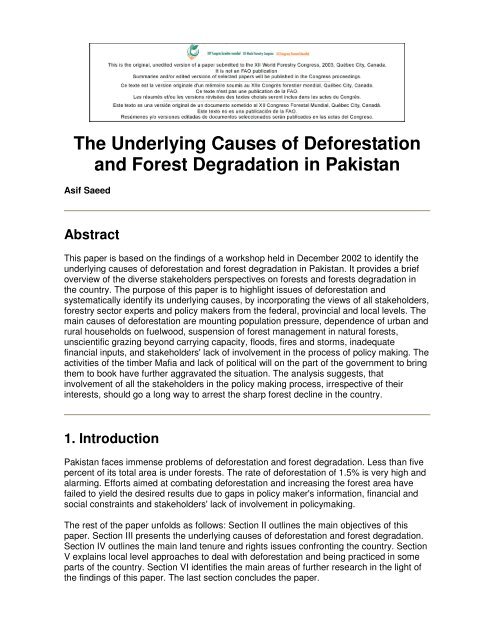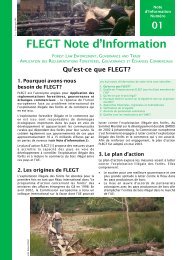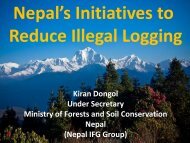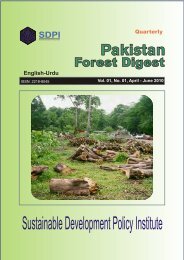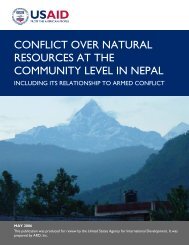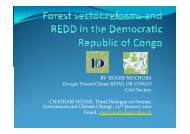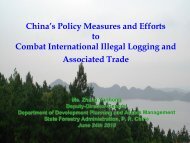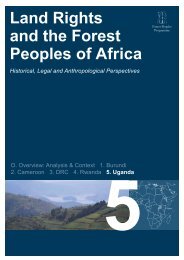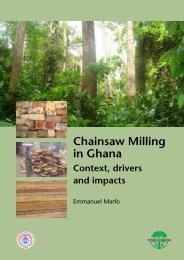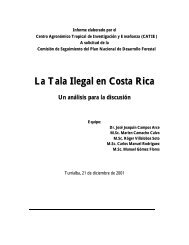The Underlying Causes of Deforestation and Forest Degradation in ...
The Underlying Causes of Deforestation and Forest Degradation in ...
The Underlying Causes of Deforestation and Forest Degradation in ...
You also want an ePaper? Increase the reach of your titles
YUMPU automatically turns print PDFs into web optimized ePapers that Google loves.
<strong>The</strong> <strong>Underly<strong>in</strong>g</strong> <strong>Causes</strong> <strong>of</strong> <strong>Deforestation</strong><strong>and</strong> <strong>Forest</strong> <strong>Degradation</strong> <strong>in</strong> PakistanAsif SaeedAbstractThis paper is based on the f<strong>in</strong>d<strong>in</strong>gs <strong>of</strong> a workshop held <strong>in</strong> December 2002 to identify theunderly<strong>in</strong>g causes <strong>of</strong> deforestation <strong>and</strong> forest degradation <strong>in</strong> Pakistan. It provides a briefoverview <strong>of</strong> the diverse stakeholders perspectives on forests <strong>and</strong> forests degradation <strong>in</strong>the country. <strong>The</strong> purpose <strong>of</strong> this paper is to highlight issues <strong>of</strong> deforestation <strong>and</strong>systematically identify its underly<strong>in</strong>g causes, by <strong>in</strong>corporat<strong>in</strong>g the views <strong>of</strong> all stakeholders,forestry sector experts <strong>and</strong> policy makers from the federal, prov<strong>in</strong>cial <strong>and</strong> local levels. <strong>The</strong>ma<strong>in</strong> causes <strong>of</strong> deforestation are mount<strong>in</strong>g population pressure, dependence <strong>of</strong> urban <strong>and</strong>rural households on fuelwood, suspension <strong>of</strong> forest management <strong>in</strong> natural forests,unscientific graz<strong>in</strong>g beyond carry<strong>in</strong>g capacity, floods, fires <strong>and</strong> storms, <strong>in</strong>adequatef<strong>in</strong>ancial <strong>in</strong>puts, <strong>and</strong> stakeholders' lack <strong>of</strong> <strong>in</strong>volvement <strong>in</strong> the process <strong>of</strong> policy mak<strong>in</strong>g. <strong>The</strong>activities <strong>of</strong> the timber Mafia <strong>and</strong> lack <strong>of</strong> political will on the part <strong>of</strong> the government to br<strong>in</strong>gthem to book have further aggravated the situation. <strong>The</strong> analysis suggests, that<strong>in</strong>volvement <strong>of</strong> all the stakeholders <strong>in</strong> the policy mak<strong>in</strong>g process, irrespective <strong>of</strong> their<strong>in</strong>terests, should go a long way to arrest the sharp forest decl<strong>in</strong>e <strong>in</strong> the country.1. IntroductionPakistan faces immense problems <strong>of</strong> deforestation <strong>and</strong> forest degradation. Less than fivepercent <strong>of</strong> its total area is under forests. <strong>The</strong> rate <strong>of</strong> deforestation <strong>of</strong> 1.5% is very high <strong>and</strong>alarm<strong>in</strong>g. Efforts aimed at combat<strong>in</strong>g deforestation <strong>and</strong> <strong>in</strong>creas<strong>in</strong>g the forest area havefailed to yield the desired results due to gaps <strong>in</strong> policy maker's <strong>in</strong>formation, f<strong>in</strong>ancial <strong>and</strong>social constra<strong>in</strong>ts <strong>and</strong> stakeholders' lack <strong>of</strong> <strong>in</strong>volvement <strong>in</strong> policymak<strong>in</strong>g.<strong>The</strong> rest <strong>of</strong> the paper unfolds as follows: Section II outl<strong>in</strong>es the ma<strong>in</strong> objectives <strong>of</strong> thispaper. Section III presents the underly<strong>in</strong>g causes <strong>of</strong> deforestation <strong>and</strong> forest degradation.Section IV outl<strong>in</strong>es the ma<strong>in</strong> l<strong>and</strong> tenure <strong>and</strong> rights issues confront<strong>in</strong>g the country. SectionV expla<strong>in</strong>s local level approaches to deal with deforestation <strong>and</strong> be<strong>in</strong>g practiced <strong>in</strong> someparts <strong>of</strong> the country. Section VI identifies the ma<strong>in</strong> areas <strong>of</strong> further research <strong>in</strong> the light <strong>of</strong>the f<strong>in</strong>d<strong>in</strong>gs <strong>of</strong> this paper. <strong>The</strong> last section concludes the paper.
II. Objectives<strong>The</strong> specific objectives <strong>of</strong> this study are to:• raise awareness <strong>of</strong> the benefits <strong>of</strong> forests, <strong>and</strong> adverse effects <strong>of</strong> deforestation;• analyze gaps <strong>in</strong> policy makers' <strong>in</strong>formation;• document the diverse stakeholder perspectives on forests;• build capacity <strong>of</strong> all stakeholders for susta<strong>in</strong>able management <strong>of</strong> forests;• suggest possible solutions to the top decision makers i.e. the M<strong>in</strong>istry <strong>of</strong> Environment,Local Government <strong>and</strong> Rural Development, <strong>and</strong> prov<strong>in</strong>cial forests departments by br<strong>in</strong>g<strong>in</strong>g<strong>in</strong>to their notice concerns <strong>of</strong> the timber traders, forest owners <strong>and</strong> purchasers <strong>of</strong> rights topolicy makers <strong>of</strong> the country.III. <strong>Causes</strong> <strong>of</strong> <strong>Deforestation</strong>Pakistan is a forest deficient country. It has suffered loss <strong>of</strong> forest biodiversity (conifers,riparian, thorn, mangroves) ow<strong>in</strong>g to poor management practices <strong>of</strong> over hundred years,which adm<strong>in</strong>ister forest systems by divid<strong>in</strong>g conifers <strong>in</strong>to periodic blocs. Policy makersgave preference to certa<strong>in</strong> species on the basis <strong>of</strong> commercial <strong>in</strong>terests. <strong>The</strong>y ignoretaxonomy <strong>and</strong> follow no scientific procedures. All these practices have led to fragmentaryecosystems <strong>and</strong> brought some species to the verge <strong>of</strong> ext<strong>in</strong>ction.<strong>The</strong> underly<strong>in</strong>g causes <strong>of</strong> deforestation, identified are as follows:1. <strong>The</strong>re is a wide gap <strong>in</strong> the production <strong>and</strong> consumption <strong>of</strong> wood. In 1993, theconsumption <strong>of</strong> wood was 29.5 million cubic meters whereas <strong>in</strong> the year 2018 it isprojected to go up by 52.6 million cubic meters. At present, Pakistan is produc<strong>in</strong>gonly 14 million cubic meter <strong>of</strong> wood. By 2020, it will require 50 million cubic meter <strong>of</strong>wood <strong>in</strong> order to cater to dem<strong>and</strong>s <strong>of</strong> the people. This wide gap <strong>in</strong> the production<strong>and</strong> consumption <strong>of</strong> wood is one <strong>of</strong> the ma<strong>in</strong> factors <strong>of</strong> deforestation.2. <strong>The</strong> ban imposed by the government on cutt<strong>in</strong>g trees has not prevented thetimber mafia from their activities because <strong>of</strong> political <strong>in</strong>terference, theft, corruption<strong>and</strong> lack <strong>of</strong> serious commitment on the part <strong>of</strong> the government to br<strong>in</strong>g the culpritsto book. <strong>The</strong> timber traders are us<strong>in</strong>g all possible means to smuggle wood for shortlivedga<strong>in</strong>s.3. Commercial exploitation <strong>and</strong> harvest<strong>in</strong>g <strong>of</strong> forests by the contractors with theconnivance <strong>of</strong> the concerned <strong>of</strong>ficials is not only exploit<strong>in</strong>g small forest owners withweak f<strong>in</strong>ancial positions but also caus<strong>in</strong>g deforestation on a massive scale. <strong>The</strong>forest department has failed to br<strong>in</strong>g them to book <strong>and</strong> rectify the situation.4. Studies carried out show rich people are <strong>in</strong>volved <strong>in</strong> the cutt<strong>in</strong>g <strong>and</strong> sell<strong>in</strong>g <strong>of</strong>trees <strong>in</strong> collusion with the timber mafia. 1 <strong>The</strong> government has failed to eradicatepoverty <strong>in</strong> forest areas, <strong>and</strong> check fuel woodcutt<strong>in</strong>g by provid<strong>in</strong>g alternative means<strong>of</strong> livelihoods. Moreover, forest management approaches <strong>and</strong> laws are heavily tilted<strong>in</strong> favour <strong>of</strong> <strong>in</strong>come generation <strong>and</strong> don't consider social <strong>and</strong> economic conditions <strong>of</strong>the communities.5. <strong>The</strong> nexus between <strong>in</strong>tegrated family health <strong>and</strong> forestry systems <strong>in</strong> the NorthWestern Frontier Prov<strong>in</strong>ce (NWFP) shows that poverty is one <strong>of</strong> the ma<strong>in</strong> factors <strong>of</strong>deforestation. Studies suggest that one s<strong>in</strong>gle illness <strong>in</strong> the household would push
the family <strong>in</strong>to the poverty trap, compell<strong>in</strong>g the people to resort to deforestation as asource <strong>of</strong> livelihoods. 26. Poor communities consume available natural resources for their immediatesurvival. For example, <strong>in</strong> the absence <strong>of</strong> the provision <strong>of</strong> gas <strong>and</strong> electricity or theavailability <strong>of</strong> renewable sources <strong>of</strong> energy at affordable rates, wood is the onlysource <strong>of</strong> energy for communities <strong>in</strong> hilly areas. Uncerta<strong>in</strong> property rights <strong>and</strong><strong>in</strong>security <strong>of</strong> tenure lead the poor to resort to actions such as cutt<strong>in</strong>g <strong>of</strong> trees. Thisevidence establishes close correlation between poverty <strong>and</strong> deforestation.7. An evidence obta<strong>in</strong>ed from Balakot, a sub division <strong>of</strong> North Western FrontierProv<strong>in</strong>ce shows that more than 80% <strong>of</strong> the population is liv<strong>in</strong>g below the povertyl<strong>in</strong>e. Lack <strong>of</strong> education, <strong>and</strong> limited means <strong>of</strong> transport <strong>and</strong> communications hasexacerbated the problem. In such a socio economic environment, it is difficult forthe people to appreciate the significance <strong>of</strong> forests <strong>and</strong> the ensu<strong>in</strong>g benefits forsusta<strong>in</strong>able development.8. <strong>The</strong> natural factors affect<strong>in</strong>g forests are arid climate, heavy dependence onirrigation water, long gestation periods <strong>of</strong> forestry, <strong>and</strong> fragile watershed &rangel<strong>and</strong>.9. Burgeon<strong>in</strong>g population pressure result<strong>in</strong>g <strong>in</strong> unsusta<strong>in</strong>able removals,dependence <strong>of</strong> 90% <strong>of</strong> rural & 60% urban households on fuelwood as primarysource <strong>of</strong> energy; suspension <strong>of</strong> forest management <strong>in</strong> natural forests, unscientificgraz<strong>in</strong>g beyond carry<strong>in</strong>g capacity, lack <strong>of</strong> adequate <strong>and</strong> susta<strong>in</strong>ed f<strong>in</strong>ancial <strong>in</strong>putsfor natural regeneration <strong>and</strong> susta<strong>in</strong>able development <strong>of</strong> fragile ecosystems(mounta<strong>in</strong>, riparian, desert, mangrove), floods, fires storms, pests <strong>and</strong> diseases,developmental pressure i.e. construction <strong>of</strong> roads, build<strong>in</strong>gs, <strong>and</strong> water reservoirsdisturb<strong>in</strong>g riparian <strong>and</strong> mangrove ecosystems lead to widespread deforestation <strong>in</strong>Pakistan.10. Stakeholders lack <strong>of</strong> <strong>in</strong>volvement <strong>in</strong> the policy mak<strong>in</strong>g process has held thepolicy makers back from design<strong>in</strong>g a broad based forest policy.IV. L<strong>and</strong> Tenure <strong>and</strong> Rights Issues<strong>The</strong> ma<strong>in</strong> l<strong>and</strong> tenure issues are lack <strong>of</strong> a sense <strong>of</strong> participation <strong>in</strong> public forests, haqdarirights <strong>in</strong> fragile watershed ecosystem (unsusta<strong>in</strong>able), tree tenure <strong>in</strong> community forests(village shamlats), tree tenure <strong>in</strong> tenant at will <strong>and</strong> l<strong>and</strong> lessees, l<strong>and</strong> tenure <strong>in</strong> guzaraforests (<strong>in</strong>dividual & common ownership).<strong>The</strong> issue <strong>of</strong> trade <strong>in</strong> rights rema<strong>in</strong>ed controversial especially <strong>in</strong> NWFP. <strong>Forest</strong> contractorsemployed by forest departments for harvest<strong>in</strong>g, road construction, <strong>and</strong> carriage <strong>of</strong> timberexploit poor locals by purchas<strong>in</strong>g their property rights. Whereas the government held thecontractors responsible for the abuse <strong>of</strong> rights, the contractors blame the forestdepartment for their <strong>in</strong>competence.<strong>The</strong> Jo<strong>in</strong>t <strong>Forest</strong> Management Committees (JFMCs), the forest department <strong>of</strong>ficials argue,are still dependent on the timber mafia from whom they have to borrow money. <strong>The</strong>re is nocredit available for JFMCs, their claim notwithst<strong>and</strong><strong>in</strong>g.
V. Local level Approaches to Deal With <strong>Deforestation</strong>Village L<strong>and</strong> Use <strong>and</strong> Plann<strong>in</strong>g (VLUP) is a new approach developed at the communitylevel for the participatory management <strong>of</strong> designated forests <strong>in</strong> NWFP. Each villagecommunity has its own (exclusive) l<strong>and</strong> use pr<strong>in</strong>ciples, which are <strong>of</strong>ten <strong>in</strong> conflict with otherstakeholder's views. Under VLUP all communities settle their disputes by com<strong>in</strong>g to termswith each other. This consensus build<strong>in</strong>g process <strong>in</strong>volves identification <strong>of</strong> units for l<strong>and</strong>use <strong>and</strong> f<strong>in</strong>alization <strong>of</strong> management plans. It calls for strengthen<strong>in</strong>g civil society at differentlevels as genu<strong>in</strong>e requirement for the success <strong>of</strong> the process.Farm <strong>Forest</strong>ry is another approach <strong>and</strong> it targets the poor <strong>and</strong> disadvantaged groupsthrough the <strong>in</strong>volvement <strong>of</strong> local CBOs <strong>and</strong> NGOs <strong>in</strong> NWFP. It was launched to check<strong>in</strong>creased pressure on the resources lead<strong>in</strong>g toward reduced vegetation cover <strong>and</strong> fertility.This participatory <strong>and</strong> holistic approach is a paradigm shift, which focuses on areas <strong>of</strong>plantation, has low opportunity cost <strong>and</strong> higher return <strong>and</strong> aims at poverty reductionthrough encourag<strong>in</strong>g enterprise. It ensures susta<strong>in</strong>ability by creat<strong>in</strong>g skills enhancement<strong>and</strong> ownership, systematic plann<strong>in</strong>g <strong>and</strong> management <strong>of</strong> the resources. If managementplans are worked out properly, it holds out greater opportunities for diversification <strong>and</strong>maximization <strong>of</strong> pr<strong>of</strong>its <strong>and</strong> leads to susta<strong>in</strong>able livelihood <strong>and</strong> positive impact on localbiodiversity <strong>and</strong> water regime.VI. Areas for Further Research<strong>The</strong> f<strong>in</strong>d<strong>in</strong>gs <strong>of</strong> this study suggest further research to carry out basel<strong>in</strong>e study to collectauthentic <strong>and</strong> reliable data on forest biodiversity <strong>and</strong> ecology. It also calls research <strong>in</strong>tohow <strong>and</strong> where GIS <strong>and</strong> remote sens<strong>in</strong>g techniques can be usefully employed <strong>in</strong> forestsciences <strong>and</strong> management <strong>in</strong> Pakistan. Improvement <strong>of</strong> forecast<strong>in</strong>g techniques (forexample, projections <strong>of</strong> rates <strong>of</strong> deforestation, changes <strong>in</strong> l<strong>and</strong> use, or estimates <strong>of</strong> soilerosion over a period <strong>of</strong> time <strong>in</strong> the future) can also play a very important role to bridge<strong>in</strong>formation gaps <strong>in</strong> the policy mak<strong>in</strong>g process. And last but not the least research <strong>in</strong>to ananalysis <strong>of</strong> what k<strong>in</strong>ds <strong>of</strong> community forestry projects work <strong>and</strong> which don't work, thereasons for success or failure <strong>and</strong> new legislation on forests use <strong>and</strong> management <strong>and</strong> tocheck trad<strong>in</strong>g <strong>of</strong> timber should go al long way to get to grips with the challenge <strong>of</strong>deforestation.VII. Conclusions<strong>The</strong>re is a need for a permanent th<strong>in</strong>k tank outside the government <strong>and</strong> advocacy groupsto support forest policy formulation <strong>and</strong> implementation process on a perpetual basis asreflected <strong>in</strong> the <strong>Forest</strong> Policy 2001. <strong>The</strong> government should focus on improvement <strong>of</strong>forest management practices to prevent the loss <strong>of</strong> biodiversity (for example, reduce thepractice <strong>of</strong> giv<strong>in</strong>g preference to certa<strong>in</strong> species for their commercial value <strong>and</strong> ignor<strong>in</strong>gother species). <strong>The</strong> <strong>in</strong>tegration <strong>of</strong> ecosystem approach <strong>in</strong>to forest management canprevent further fragmentation <strong>of</strong> forest habitats.<strong>The</strong> government needs to <strong>in</strong>corporate taxonomy <strong>in</strong> forest management. Includ<strong>in</strong>g women<strong>in</strong> forest management decisions <strong>and</strong> forestry projects should address the genderdimensions <strong>of</strong> deforestation. In the f<strong>in</strong>al analysis the effective enforcement <strong>of</strong> the exist<strong>in</strong>glaws <strong>and</strong> regulations on forests use <strong>and</strong> management <strong>and</strong> <strong>in</strong>volvement <strong>of</strong> the communities<strong>in</strong> the policy mak<strong>in</strong>g process from the very outset enables the government to address <strong>and</strong>
arrest sharp forest decl<strong>in</strong>e by creat<strong>in</strong>g a feel<strong>in</strong>g <strong>of</strong> sense <strong>of</strong> ownership <strong>and</strong> empowermentamong communities.1Zia, S. (2002) "Communities <strong>and</strong> <strong>Forest</strong>s: Indigenous Capacities <strong>and</strong> the Rights <strong>of</strong> the<strong>Forest</strong> Dependent Communities" A paper presented <strong>in</strong> workshop on underly<strong>in</strong>g causes <strong>of</strong>deforestation <strong>and</strong> forests degradation <strong>in</strong> Pakistan held <strong>in</strong> Islamabad LEAD Pakistan.2Zia, S. (2002) "Communities <strong>and</strong> <strong>Forest</strong>s: Indigenous Capacities <strong>and</strong> the Rights <strong>of</strong> the<strong>Forest</strong> Dependent Communities" A paper presented <strong>in</strong> workshop on underly<strong>in</strong>g causes <strong>of</strong>deforestation <strong>and</strong> forests degradation <strong>in</strong> Pakistan held <strong>in</strong> Islamabad LEAD Pakistan.


